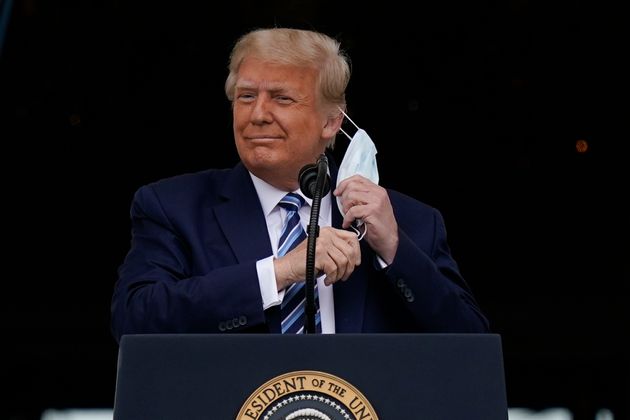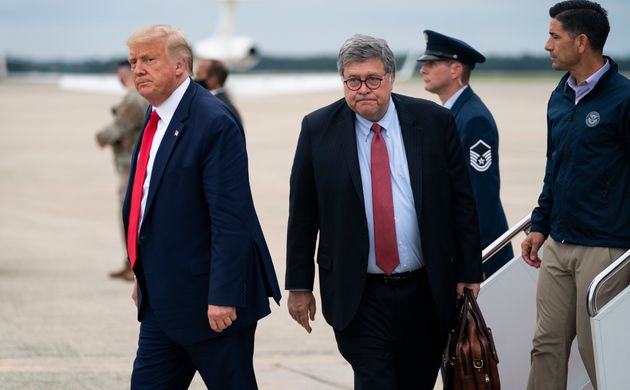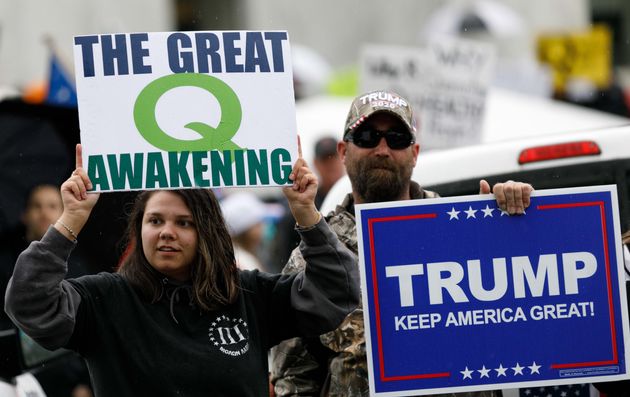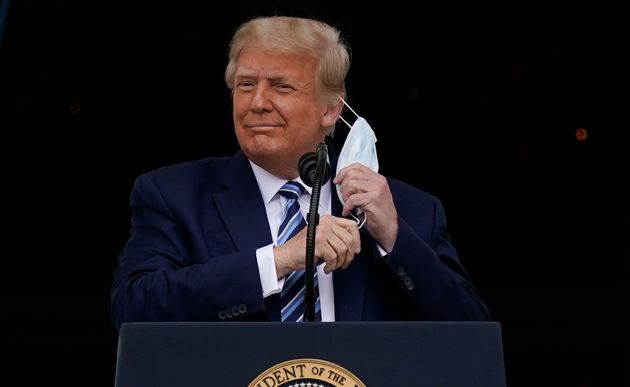
When Donald Trump kicked off his presidential bid in 2015, he rode down a golden escalator in Trump Tower, using the media attention to promote his own brand and property. He lied. He made racist comments. And he exaggerated the crowd size.
In other words, he showed exactly the type of president he would become.
The rest of his campaign was no different. He continued to stoke racial tensions, bully and demean.
Unable to believe that he could truly be as bad as he presented himself, some Democrats thought maybe Trump would change once in office. Maybe there would be a way to work with him. Chuck Schumer, a top Democrat, said there were areas where Trump “voiced very progressive and populist opinions,” and perhaps those would be areas of cooperation.
“I don’t think it makes sense to say, ’No, we’re not gonna work in any way in any form with the Trump administration,’” senator Bernie Sanders said at the time.
🇺🇸 Running Mate is a US election podcast – just for Brits. Now available everywhere.
The late civil rights icon representative John Lewis was one of the few Democratic members willing to call Trump out and speak forcefully against him. Even before Trump’s inauguration, Lewis said he was not a “legitimate” president. Some Democrats supported Lewis, but plenty distanced themselves from him and said he had gone too far.
Meanwhile, top Republican leaders, when asked about Trump’s rampant dishonesty during the course of the campaign, offered assurances that a Trump presidency would be different. They said the burdens of the Oval Office would weigh on him, and he’d have a competent team of aides. The Trump White House, they said, would function like most others.
“I think many Republicans who held their nose and voted for Trump in 2016 thought he would at least be surrounded by seasoned staffers and career Republicans who would provide the policy road map for the administration,” said Jennifer Pierotti Lim, the co-founder of Republican Women for Progress, who endorsed Hillary Clinton in 2016. “But as we’ve seen, Republicans have abdicated their responsibility and instead of putting our country first, they have elevated Trumpism in all its forms.”
Every warning we made about Trump’s unique badness has seemingly come true.Ian Sams, Clinton campaign spokesperson.
Trump has been exactly the man he presented himself to be during the campaign, if not worse. He largely abandoned his populist promises to pursue the same trickle-down economic policies that are standard for Republicans. He has continued to make racist and sexist remarks – and pursue those sorts of policies – and has used the presidency to enrich himself and his family.
Various Democrats told HuffPost that Trump has indeed been worse than they expected.
“I thought he would be not just focusing on [infrastructure] but sustain the focus, would be in communities talking about – just bridges, for example,” said senator Bob Casey. “I thought he would use the opportunity to try to help rebuild the country. I thought he missed a big opportunity. Of course, I never thought he would abuse his power the way he did.”
Senator Jon Tester said he expected Trump to at least try to get bipartisan agreement on some matters.
“He just wasn’t interested in that at all,” Tester said. “It surprised me.”
The lack of bipartisanship has been laid bare in the past few weeks as Trump, with the full support of Senate Republicans, has tried to push through Amy Coney Barrett to replace liberal icon Ruth Bader Ginsburg on the Supreme Court. The vote is likely to come just one week before the election, although Republicans protested when Barack Obama tried to fill the seat of the late Antonin Scalia months before the 2016 election.
Trump personally lied about the size of his inauguration crowd on his first full day in office, standing before a memorial to agents killed in the line of duty at CIA headquarters. Sean Spicer, his press secretary, repeated and embellished the lie later that afternoon, and the tone was set for the coming four years.
To date, Trump has made tens of thousands of false statements, about matters great and small. A significant percentage of them have been lies: things that he has been told were false but that he repeated anyway, such as his claim that he signed into law the Veterans “Choice” Act, or that his tax cuts were the largest in American history.
“If you look back to the 2016 campaign, every warning we made about Trump’s unique badness has seemingly come true – but it’s not enough to just say ‘I told you so.’ Voters have to be shown the math,” said Ian Sams, who served as a spokesperson for Clinton’s presidential campaign. “Sadly, these past four years – and especially the pandemic – have revealed too clearly the depth of Trump’s fraudulent pitch as a tough, problem-solving leader, and most Americans now see him for the failure he is.”
In many ways, Trump has turned out to be the worst version of what people feared. He has separated immigrant children from their parents, emboldened white supremacists, flattered strongmen who run dictatorships and treated the presidency like his own private business.
“I often say there [were] many shocks but there was never a surprise,” said senator Tim Kaine, the Democratic vice presidential nominee in 2016.
The consequences of his incompetence have been deadly. He may not have known the coronavirus was coming, but he could have been better prepared. And his inability, or unwillingness, to shepherd the country through the crisis has made his presidency even worse than some of his critics feared, as the death toll from the coronavirus rises to more than 220,000 Americans.
Here’s a look at the some of the ways Trump has exceeded expectations on just how low he’d go:
Separating Families And Decimating Legal Immigration

Trump began his campaign obsessed with immigration and vilifying immigrants. Undocumented immigrants, a majority of whom are Latino, Black or Asian, were not surprised that Trump followed through.
“We knew who Donald Trump was,” said Greisa Martinez, executive director of United We Dream Action, the political arm of an immigration advocacy group. “We never thought that Trump wasn’t serious. We believed that he would drive a white nationalist agenda.”
Soon after Trump took office, he enacted a disastrous travel ban for several Muslim-majority nations that left people stranded in airports or unable to reunite with their families. While the initial ban was blocked in court, Trump eventually found one that worked. He cut refugee resettlement to record low levels. He ended prioritisation for deportations, putting more undocumented immigrants who live in the US at risk of removal. He repeatedly went after so-called sanctuary cities that have policies to limit cooperation with immigration enforcement. He decimated the legal immigration system and raided Pentagon funds in order to pay for his border wall.
Some of his most aggressive actions were reserved for migrants detained at the border – including children. The Trump administration separated more than 4,200 kids from their parents at the border, without a plan to reunite them, according to the American Civil Liberties Union. Hundreds of these families are still ripped apart. The administration put children in temporary holding facilities that looked like cages and locked up families for months. They chipped away at asylum and other legal relief in the courts, and ultimately implemented the “Remain in Mexico” program to force asylum seekers to wait across the border for hearings. Once the coronavirus pandemic started, the administration began to turn away people at the border entirely.
That’s not even counting the things Trump wanted to do, but didn’t succeed in: changing “birthright citizenship” so babies born in the US wouldn’t automatically be American citizens; ending the diversity lottery, which grants visas to people from nations the president derided as “shithole countries”; cutting family reunification visas that his allies dismiss as “chain migration”; and more. Although he was blocked in court from ending the Deferred Action for Childhood Arrivals program, or DACA, the administration delayed renewals even after the Supreme Court ruling.
Martinez wasn’t shocked at Trump’s ability to push white nationalist policies. But the way the rest of the government went along – Congress, courts and federal agencies alike – was dismaying. The “biggest surprise” for her, she said, was “the inability of the rest of our democratic system to be able to apply checks and balances.”
Corrupting Justice

Trump’s presidency has devastated the standing of the Justice Department (DoJ) and the FBI. From the beginning of his 2016 campaign, fuelled by chants of “lock her up” aimed at Clinton, Trump has treated the Justice Department as a means of protecting his political interests and punishing his political enemies.
Trump has plowed through the normal restrictions meant to guide contacts between the White House and the Justice Department and prevent improper political interference in DoJ’s law enforcement mission. He’s unleashed an extensive campaign against the FBI, accusing the nation’s buttoned-up and conservative-leaning leading law enforcement bureau of being behind some secret cabal to take him down, and leaving the bureau to deal with the long-term, real-world impact on its reputation.
Trump fired former FBI director James Comey on a false pretext and forced former attorney general Jeff Sessions to resign. Attorney general William Barr, once thought to be an institutionalist who would stand up to improper political interference, instead protected the president from political harm by spinning and mischaracterising the findings of Robert Mueller’s special counsel report on Russian interference in the 2016 election.
As laid out in Mueller’s report, Trump worked to interfere in the investigation into wrongdoing. The only thing that protected Trump from a definitive accusation that he committed crimes was a Justice Department memo that found it was unconstitutional to indict a sitting president and improper to accuse Trump of committing crimes without formally charging him.
Some Republicans hoped that the Mueller report – as well as Trump’s impeachment for trying to pressure a foreign country to launch a politically damaging investigation against former vice president Joe Biden – would chastise the president and teach him a lesson. Yet just weeks before the election, Trump was publicly calling for the Justice Department to use its powers to attack Biden, his chief political rival.
“We’ve gotta get the attorney general to act. He’s gotta act. And he’s gotta act fast. He’s gotta appoint somebody,” Trump said on Tuesday. “This is major corruption and this has to be known about before the election.”
Giving Life To Conspiracies And The Far Right

Trump retweeted a post this month to his 87 million followers suggesting that Biden and Obama “may have had Seal Team 6 killed,” and that al Qaeda leader Osama bin Laden was still alive. A link in the post alleged that the person gunned down in the US Special Forces’ raid on May 2, 2011, was not bin Laden but a body double.
“I don’t take a position,” Trump later said in defence of the retweet. “I’ll put it out there, and people can decide for themselves.”
Under normal circumstances, a sitting US president pushing – and then defending – such a ludicrous conspiracy theory would be front-page news across the country and beyond. But throughout his time in office, and even before, Trump has openly embraced disinformation that is flattering to him or paints his rivals in a negative light, facts be damned.
His Twitter account has become an integral part of the far right’s fake-news pipeline, with falsehoods worming their way from fringe websites to hyper-partisan social media influencers to media outlets such as the One America News Network and Fox News and, finally, to Trump’s retweets.
Trump has amplified disinformation from the start. As he campaigned for the presidency in 2016, he aggressively zeroed in on the false, bad-faith notion that Obama was not a US-born citizen – an already-debunked lie that he’d been promoting for years. Trump is now pushing a similarly untrue birther rumour about Democratic vice presidential nominee Kamala Harris.
Among the dizzying list of other baseless or disproven conspiracy theories Trump has spread: news anchor Joe Scarborough murdered his intern;Obama wiretapped Trump’s phones; windmills cause cancer; an anti-racist protester who suffered a brain injury at the hands of police faked his wounds; Bill Clinton killed Jeffrey Epstein;Bidenis a pedophile.
Now, Trump has opened his arms to QAnon, the far-right conspiracy movement that claims a “deep state” cabal of Satan-worshipping Democrats is running an underground child sex ring with Hollywood elites. QAnon adherents believe Trump is single-handedly saving the world from this cabal, and Trump has repeatedly declined to deny this. He has referred to QAnon followers as “people that love our country.”
As Trump has amplified conspiracy theorists, he has also emboldened far-right extremists. Earlier this month, the FBI charged a group of militia members – most of them Trump supporters – with plotting to violently kidnap Michigan governor Gretchen Whitmer, a Democrat. Trump had repeatedly condemned Whitmer for coronavirus lockdown measures, and in April tweeted “LIBERATE MICHIGAN.” After the plot was foiled, Trump continued to stoke hate, while a crowd at a Trump rally in Michigan chanted “Lock her up,” referring to Whitmer.
Michigan may have narrowly avoided a violent extremist attack, but during the Trump administration, far-right violence has surged around the country. Domestic terrorism is the deadliest it has been in decades, and a resurgent far right is now one of the country’s biggest national security threats. White nationalist attackers have left manifestos that closely align with the same grievances Trump has fomented at rallies, in speeches and on Twitter. Many attackers have been open and enthusiastic Trump supporters, targeting groups, such as Muslims, immigrants and journalists, that the president constantly vilifies.
Trump has sometimes given perfunctory condemnations of such violence, before immediately returning to fanning its flames. After neo-Nazis held a deadly rally in Charlottesville, Virginia, in 2017, Trump claimed there were “very fine people” on both sides of the confrontation there. During the first 2020 presidential debate, Trump told the Proud Boys, a violent far-right gang, to “stand back and stand by.” Within hours, members of the group had added the slogan to their online profiles as they basked in the president’s approval.
In Trump, far-right extremists and white nationalists have found a vehicle to mainstream their beliefs and turn them into policy. Fringe, racist ideology that had languished in far-right online spaces has been given a direct line into Trump’s White House, with leaked emails showing that adviser Stephen Miller recommended articles from white nationalist sites and abhorrently racist literature in exchanges with far-right media.
Trump’s tacit embrace of white nationalists and the far right has made him an icon for extremists around the world. Researchers of the far right long ago began to look for Maga symbolism in online profiles and groups, finding that it was one of the easiest ways of tracking extremism. German and Italian far-right politicians have posed in Trump hats, as did an extremist who killed six Muslim men at a Quebec City mosque in 2017. One of Trump’s avowed fans is the leader of a German far-right network that was stockpiling body bags and weapons as it planned to kill politicians who supported refugees.
Treating The Presidency As His Own Business

Trump’s mendacity has been matched by his personal corruption, as he’s used his office to funnel millions of taxpayer and donor dollars into his own pocket, as well as openly solicit money through his hotels and golf courses from both domestic and foreign interests that had business before his executive branch agencies.
By insisting on visiting his own properties hundreds of times to play golf and for official and campaign trips, Trump put at least several million tax dollars into his own cash registers in the form of room rentals and meals for Secret Service and other government employees who must travel with him. The exact amount is not known, because the White House refuses to turn over those records.
According to Federal Election Commission filings, Trump has also diverted $8 million in Republican donor money into his businesses since taking office. His golf clubs and hotels – particularly his Washington, DC, hotel just blocks from the White House – became attractions for lobbyists who wanted Trump to know they were spending money that would benefit him personally.
Robert Weissman, president of the liberal watchdog group Public Citizen, said he expected Trump would be corrupt when he was elected.
“Still, it was hard to imagine the enormity and complete pervasiveness of the corruption we have experienced,” he said. “It was equally difficult to foresee that Trump and his administration wouldn’t even bother to hide the corruption – from rampant abuses of the Hatch Act to putting a former coal lobbyist in charge of the Environmental Protection Agency.”
The blurred line between the presidency and Trump’s own personal interests was on full display this summer at the Republican National Convention, when Trump took the unprecedented step of giving his acceptance speech at the White House. Traditionally, presidents keep political rallies and activities separate from their official government functions. The convention ended with Trump and his supporters standing at the White House, watching a fireworks display over the Washington Monument.
Deadly Incompetence

Many people who voted against Trump crossed their fingers that there wouldn’t be a serious national emergency during his term that would require true presidential leadership.
But there was, and there is.
The coronavirus pandemic has brought all of Trump’s incompetence into focus.
Trump wasn’t prepared for a pandemic that has claimed the lives of hundreds of thousands of Americans and continues to grow worse. He has tried all his usual tactics of hiding it, blaming it on his enemies and slapping some different branding on it. But it’s not working. And this time, the consequences are deadly.
From the early days, Trump knew how dangerous the virus was, telling journalist Bob Woodward in early February that it was “deadly stuff.” But publicly, he downplayed it. He compared it to the flu and predicted it would go away on its own once April came, or when the weather warmed up.
He also pushed quack coronavirus “cures” – like taking the drug hydroxychloroquine or injecting bleach – even after the medical community said they were ineffective or even dangerous. Meanwhile, he mocked masks and tried to push away and discredit the scientific community, which refused to get on board with his administration’s agenda of downplaying the virus’ severity.
Getting sick himself didn’t change anything. Trump announced that he and his wife, Melania, had contracted the coronavirus on October 1, after months of not wearing masks and continuing to hold events in person. He and his White House became super-spreaders, with at least 35 people in his orbit testing positive for the virus.
Yet while still sick at the hospital, he risked the life of Secret Service agents, and everyone else he came into contact with, when he left the building to ride around in the presidential motorcade and wave to supporters. He then left the Walter Reed Medical Center and returned to the White House – even though he was still sick and contagious – where he promptly took off his mask while standing on the balcony for photos.
Since then, the White House has embraced the idea of allowing the virus to essentially spread unchecked, while trying to protect the elderly and vulnerable. Leading experts say this strategy is dangerous, and reaching the point of “herd immunity” is much further off than the administration seems to think it is.
Igor Bobic contributed reporting.



